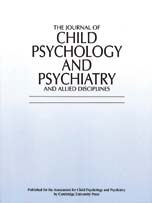No CrossRef data available.
Abstract
Child health professionals are keen to understand the origins of antisocial behaviour. Ben Lahey and colleagues, in this issue's Annotation, remind us of the evidence that it may reflect individual propensities to be impulsive, to have high activity levels with greater than average physical strength, coupled with low intelligence and a sense of daring. Youths with an earlier age of onset, before adolescence, are more likely than those with later onset to meet criteria for ADHD, but whether ADHD as such predisposes boys to engage in antisocial acts is unclear. Oppositional Defiant Disorder may be the more relevant influence. They discuss the role of “intelligence” in protecting against the development of antisocial behaviour, in particular the importance of reasonably good verbal abilities. Interestingly, Lahey et al. take the view that we are not yet in a position to be sure whether specific cognitive deficits are important predisposing factors for antisocial behaviour. They suggest that a more parsimonious way of looking at cognitive influences is to consider the global trait of intelligence without being more specific until better evidence emerges. For clinicians who wish to identify children who may be at high risk of antisocial behaviour, it is also important to think about parenting variables that may predispose to its development. These include the use of harsh discipline, lack of parental supervision, and antisocial parental attitudes. Finally, they note there is increasing interest in the influence of gender on the development of antisocial behaviour. This article is concerned exclusively with boys, and there is so far no truly convincing explanation for the remarkable differences in prevalence of such behaviour between the sexes. Girls appear to be easier to socialise, and boys have poorer communication skills in the preschool period. This aspect of sexual dimorphism is worthy of further investigation, perhaps from the perspective of gender differences in social cognitive development.
Helen Rushforth offers a Practitioner Review whose purpose is to offer guidance to practitioners who are responsible for communicating with hospitalised children. She presents not only a literature review, which is derived from the theories pertaining to children's conceptualisation of health and illness, but her paper also gives guidance to practitioners on how to communicate effectively with children of different ages, and in different clinical situations. The paper focuses on a range of contemporary issues including pre-procedural preparation, children's health promotion, and the need to convey health promotion messages to young children. She discusses the competence of children to give consent for surgery, and the criteria by which their competence to gain contraceptive advice without parental consent may be judged.
- Type
- Editorial
- Information
- The Journal of Child Psychology and Psychiatry and Allied Disciplines , Volume 40 , Issue 5 , July 1999 , pp. 665 - 667
- Copyright
- © 1999 Association for Child Psychology and Psychiatry


